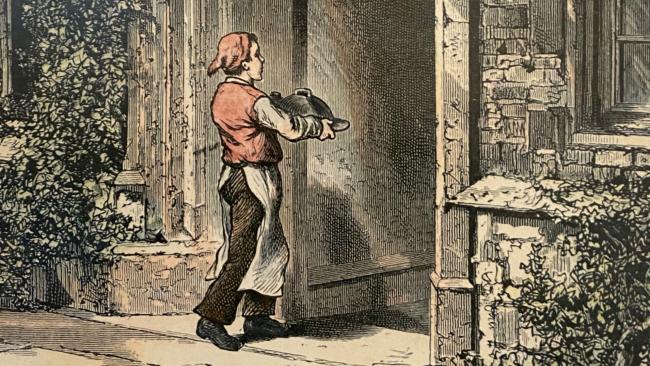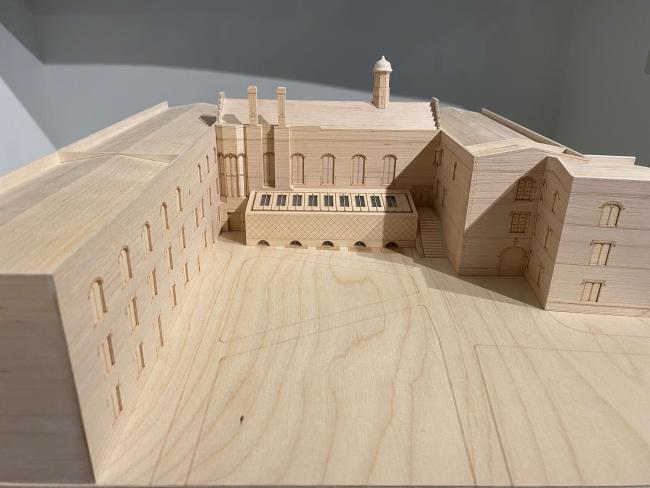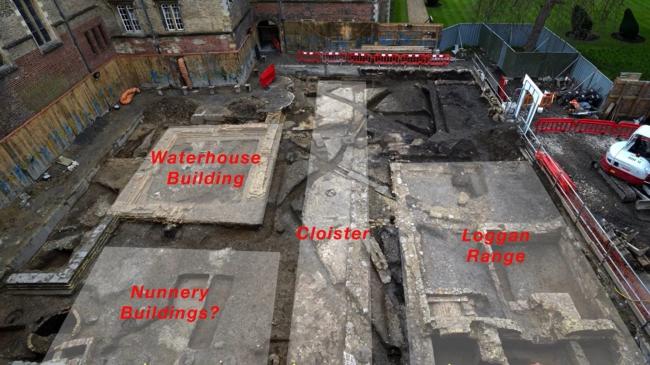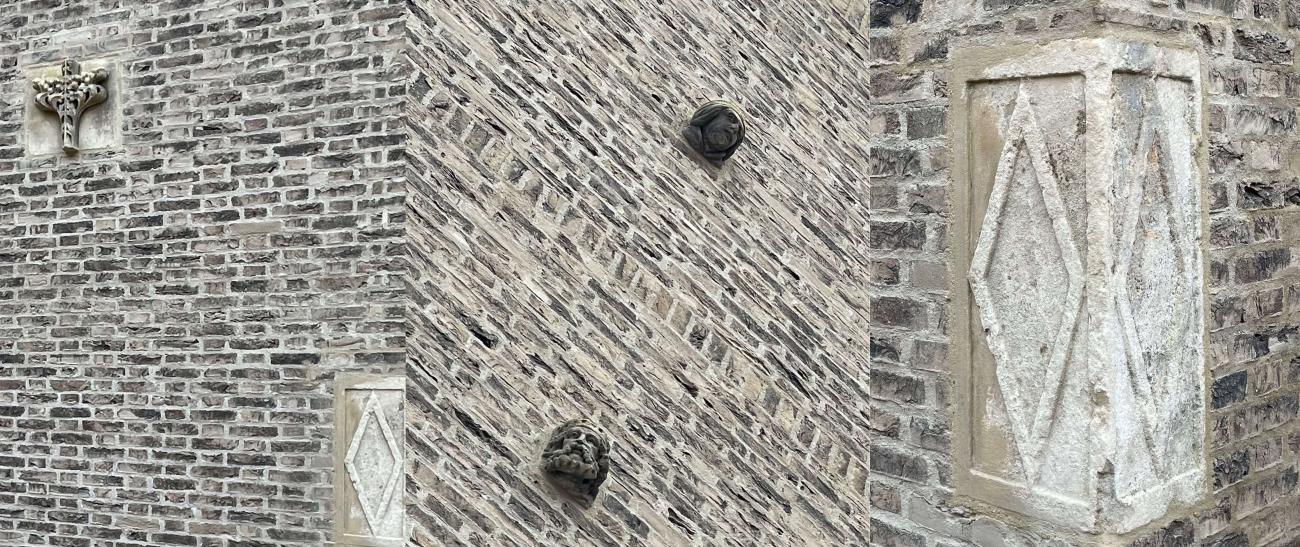
Food and Feasting at Jesus College
To mark the completion of the Kitchen Redevelopment Project, Jesus College Archives has put together an exhibition that traces the history of food and feasting from the time of the Priory of St Mary and St Radegund to the present day.
The exhibition, which is open daily until the end of March, celebrates the Hall as a place to socialise, create friendships, and as a setting for the intellectual exchange of ideas. If you are unable to attend the exhibition in person then this article explores the tradition of communal eating on the site of Jesus College since c. 1150.
The Nuns’ Refectory
The medieval priory of St Mary and St Radegund was established c. 1150 and was situated on this site before the foundation of the College on 12 June 1496, when Henry VII issued Letters Patent to Bishop Alcock of Ely authorising him to suppress the nunnery of St Radegund and to use its property to found a College. The College Hall is still located in the same position as the nuns’ refectory: above a buttery and cellars which are now the new kitchens. During the medieval period, a bell would have summoned the nuns to meals in the refectory and they would have ritually washed their hands at a laver located in cloister walk. During the meal, a nun read spiritual texts from an elevated pulpit whilst the others ate in silence. The nuns were seated according to seniority, with the Prioress and senior nuns seated on a raised dais at the eastern end, similar to the College tradition where the Master and Fellows sit at High Table.
The College Archives hold a number of account rolls from the time of the Priory of St Radgeund that give researchers an interesting insight into the day-to-day lives of the nuns. The account roll shown here is the earliest of the accounts that is known to survive. It covers the years 1449-1450 and contains information relating to all aspects of life in the Priory including a detailed record of amounts spent on food. The list of food purchased by the nuns includes: bread, beer, the flesh of cows, pigs, sheep, veal, piglets, chicken, fowl, lambs, butter and fish.
This sample of animal bones was found during excavations for the new College Library in 1993 and dates to the nunnery phase of the College site. Amongst the 1.5 kilograms of animal bones that date from this period, examples were found of chickens, fish, pigs and piglets, cows and sheep.
Everyday Eating in Hall
Once the College was founded in 1496 the tradition of communal eating continued with students taking their meals together in Hall. However, the experience was not the same as it is today. In the 16th Century, dinning in Hall was obligatory for all – a quasi-monastic occasion with grace and Bible readings, followed by modest conversation (during which nobody was to be ‘noisy, wordy, quarrelsome or abusive’). Anyone who dared to speak in any language other than Latin was to be rebuked ‘with moderation’, and that rebuke was to be received by the offender ‘with patience and mutual charity’. College members were also warned to ‘abstain from tippling and drunkenness’.
The earliest statutes of the College (1515-16) provided for one Fellow to act as Seneschal with ‘knowledge and supervision in the purchase, preparation and laying out of all victuals’. Food for Master and Fellows was not to cost more than 14d a week, for ‘boys and other Scholars’ 8d; but things improved on festival days, and at Christmas everyone got to feast on boar.
The 17th Century Stewards’ Account Book, shown above, contains a list of Fellows, their meals, prices of courses, and weekly notes of prices of separate items such as butter, sea-coal, charcoal and sugar.
Complaints
Food was not always of the quality that it is today. In the mid-nineteenth century the food was generating horrified protests at a number of Colleges including Jesus. Arthur Gray (Master 1912-1940), who was an undergraduate at Jesus in the 1870s, claimed that Hall was ‘deadly cold’, that ‘bleeding bullocks hearts’ were served twice weekly, and that ‘frozen gravy and caterpillars supplied with the vegetables were principal constituents in our diet’ (Arthur Gray, ‘Some memories of 50 years’, The Chanticlere: Lent Term 1922, p.11).
Hall
The words from Psalm 133, ‘Ecce quam bonum et quam iucundum fratres habitare in unum’ [Behold how good and how joyful it is for brothers to live together in unity], are incised in gold letters in Hall, emphasising the fact that living together has always meant eating together. However, the layout of the Hall has traditionally reflected the hierarchy within College. There was a ‘high table’ raised on a dais at one end at which the Master and Fellows dined with the students sitting separately. It is significant that as part of the current kitchen renovation at Jesus College the dais has been removed.
In 1830 the Master and Fellows agreed to a request to establish dedicated ‘pensioners’ tables’ in the Hall which further underlined these status divisions. The request was received from the Pensioners themselves who wanted exclusive use of some of the tables in Hall. Unlike the other students, who were either Scholars (who received some money towards their fees) or Sizars (who financed their studies by undertaking duties within College), the Pensioners, who often had entitled backgrounds and paid for their education, often expected to be offered a higher standard of living. Therefore, a special ‘Hall Fund’ was set up to fund the supply of linen, crockery and plate for the tables.
Evidence for the ‘Hall Fund’ can be found in the College Archive’s Hall Fund Book [Ref: JCAD/2/2/10/3], which contains the accounts to fund the Pensioners’ Tables. In addition, the College’s Conclusion Book [Ref: JCGB/1/2/3] provides the Council Minutes of 1830 that allow for the purchase of cutlery and crockery for the Pensioners’ tables:
That 15 dozen knives, 10 dozen silver forks, one dozen silver table spoons, one dozen silver gravy spoons, two dozen silver salt spoons, a sufficient number of plates and dishes and of water plates and pint tumblers be purchased for the Pensioners table and that the expense be defrayed out of the Hall Fund.
Such silver cutlery, photographed above, can still be found within the College Collections and is inscribed with the line ‘in usum Pens: Tab: 1830’ [for the use of the Pensioners’ Table 1830]. The Pensioners’ Table was not long lasting though, and the Fund was wound up in Michaelmas Term 1842, a mere twelve years after its conception.
Celebrations
In addition to everyday meals the Hall has always been a place where the College has come together to celebrate. This includes societies, academic clubs, sporting achievements, special dates in the annual calendar and anniversaries of Fellows past and present.
Audit Feast
One of the most important dates in the annual calendar at Jesus College is that of the Audit Feast. Income from estates, along with other financial transactions, was audited each financial year. As College income and expenditure was extensive, auditing was a lengthy process and involved collating financial information recorded by individuals within the College including the Steward, Butler, and the Master.
A celebratory ‘Audit Feast’ was held to mark the end of the Audit. This feast, taking place at the beginning of December each year, is a tradition still marked today. As the College community often left before Christmas, the Audit Feast was also a chance for members of the College to gather before the festive season. There is evidence in the Archive suggesting that the Hall was decorated for Christmas, with various historic Porters’ bills recording payments for ‘greens for the Hall’.
The Audit Feasts were elaborate affairs with receipts and invoices showing the types of food on offer. In 1815 dishes included: ‘roast fowls, Italian cheese, apple pie, custards, jelly’ and some suitably festive ‘mince pies’. Less appealing dishes include ‘roast udder, stewed eels and pig’s face’.
College Butler
The College Butler was responsible for the buttery, the wine cellar and the College silver. Richard Brett was the Butler at the time of the 1815 Audit Feast. He was paid £14 4s 1d for supplying items for the Feast including bread, butter, cheese, Audit Ale, mild ale, 10 bottles of sherry, 14 bottles of port, tea and coffee for 16 people, two packs of cards, candles, and the cost of employing a scullion and a laundress, presumably to undertake extra cleaning on top of their usual duties.
College Cooks
The earliest statutes of College (1515-16) provided for the employment of a cook ‘honest and provident’ to be paid 26s 8d annually and assisted by a scullion to be paid 13s 4d. The cook was not categorised as a servant like others in College, instead he was an independent contractor running his own business in the kitchens. He was responsible for supplying equipment such as pots, pans, and utensils, and would take them with him when he left his employment.
As few Fellows ever shopped for food items themselves they had to accept the prices he set for the meals he supplied. This provided an opportunity to make large profits. Some cooks built up small fortunes and rose to become property owners and members of the ‘gentleman’ class in Cambridge society. In 1899 cook Samuel Kettle’s estate was valued at almost £8,000 making him one of the wealthiest men in College.
Another such cook was John Willis who is well documented in the College Archives. Willis was employed as the cook between c.1783 and 1830 and he managed to make a very comfortable living from the position. In his will he left £4,000, property in All Saint’s Parish, and four houses in Jesus Lane.
This deed is for a property in King Street which was purchased by John Willis in 1820.
Complaints were made about the amount Willis charged for food. In 1824 he was made to sign an agreement that stipulated he was to deliver a weekly account to each gentleman ‘printed and fairly filled up according to the form drawn out’. For every omission in delivery or inaccuracy found he was liable to pay a fine of one guinea to the Steward of the College to be given to the Fund of Addenbrooke’s Hospital. The terms of the agreement, signed by Willis, and an example of the form to be completed can be seen here on the inside cover of the Steward’s Account Book.
When Willis died, all the cooking utensils and serving dishes were inherited by his wife Mary. A letter of recommendation was written by one of the Fellows (below) which referred to her as having had the chief management of the kitchen for some time past, describing her as having ‘worked very hard and given satisfaction…she is very careful and industrious in addition to being skilful as a cook’. It was recommended that she be appointed for a year. She continued to run the kitchen for the next eight years.
After Dinner
An important part of the Butler’s role within college has always been the provision of after-dinner indulgences and digestifs. A receipt from Beaumont Prior, the College Butler, for items ordered just before Christmas 1772, Butler’s Audit Receipt [JCAD/2/2/9/1772/8], includes, ‘five bottles of Madeira, one bottle of Mountain [a fortified dessert wine from the Malaga area of Spain] six bottles of Port, tea and coffee for eight, sizings and pipe tobacco’.
Clay pipes would have been given to attendees of College feasts. Pipes and jars of tobacco were bought from the tobacconist on the corner of Rose Crescent until smoking became socially unacceptable and the tradition stopped in the 1990s.
Kitchen Redevelopment
As this study of food and feasting has shown, the kitchens and the Hall have always been at the heart of the College, socially and physically. However, it was decided that the kitchens and support areas no longer met the high expectations that the College has for the provision of food and drink. As a result, a major refurbishment project has been undertaken to provide the highest quality facilities. A basement under Pump Court has been built to house plant rooms, storage areas, and a wine cellar. It connects with a new double-height, single-storey kitchen extension and a three-storey extension to Upper Hall.
Archaeology
Before building got underway, Cotswold Archaeology, with assistance from Cambridge Archaeological Unit, were invited to carry out excavations of Pump Court. This excavation revealed a complex story of multiple buildings from the seventeenth century onwards all of which supported the work of the kitchens. A full archaeological report will follow in 2023.
It has always been presumed that the College fossilised the plan of the nunnery; however, the archaeologists have uncovered new and very important evidence of a wall and floor of a medieval cloister, running parallel to the existing College Hall (https://www.jesus.cam.ac.uk/articles/archaeologists-unearth-medieval-st…).
The archaeological evidence also shows that stones from the nunnery were reused in later buildings (spolia), and in this tradition some of the stones uncovered during the digs have been incorporated into the outside wall of the new kitchen extension (see photograph).
Environmental Considerations
Jesus College is committed to becoming the leading College in Cambridge on sustainability initiatives and results. The built environment is the primary focus of this commitment with modern energy solutions being combined with historic conservation. A ground source heat pump, located in the College grounds will entirely heat and cool the new buildings. Induction cooking, anaerobic digestion systems, and sustainable food sourcing have also formed part of the project.
Kitchen Opening
The first meal was served from the new kitchen on Wednesday 7th December 2022, returning the tradition of communal eating to the heart of the College, where it has been for nearly 900 years. As can be seen, the first menu and photographs after the redevelopment of the kitchens have already been accessioned into the College Archives allowing future generations of students, alumni and researchers to continue to document this incredible journey of Food and Feasting at Jesus College.
![Account Roll [Ref: JCMR/Gray 11-17/Acc. 1-3/Acc. 1] Account roll showing the earliest accounts of the Priory of St Radegund](/sites/default/files/styles/max_650x650/public/jcmr_gray_11-17_acc._1-3_acc._1_0.jpg?itok=ew8h44AP)
![Animal Bones [Ref: JCARCH/JES93] Animal bones](/sites/default/files/styles/max_650x650/public/jcarch_jes93.jpg?itok=NvsTFF_h)
![Steward’s Account Book, 1663-1667 [JCAD/8/4/1/3] 17th Century Stewards’ Account Book](/sites/default/files/styles/max_650x650/public/jcad_8_4_1_3.jpg?itok=JUhQsgS4)
![Silver cutlery inscribed with ‘in usum Pens: Tab: 1830’ [for the use of the Pensioners’ Table 1830] Silver cutlery](/sites/default/files/styles/max_650x650/public/for_the_use_of_the_pensioners_table_1830.jpg?itok=iZH2YvRU)
![The Roosters Annual Dinner in Hall, November 1935 [Ref: JCCS/4/8/1935/2] Dinner in Hall](/sites/default/files/styles/max_650x650/public/jccs_4_8_1935_2.jpg?itok=WU_ulqkq)
![Receipt for Audit Dinner, 1815 [Ref: JCAD/2/2/9/1816/26] Receipt for food and drink](/sites/default/files/styles/max_650x650/public/jcad_2_2_9_1816_26_0.jpg?itok=2i7poWO9)
![Bargain and Sale, 1820 [Ref: JCAD/3/CAM/KING/15/1/1820/1] Deed of sale](/sites/default/files/styles/large/public/jcad_3_cam_king_15_1_1820_1.jpg?itok=XZvd00N_)
![Steward’s Account Book, 1824-1844 [JCAD/8/4/1/10] Inside cover of the Steward's Account Book](/sites/default/files/styles/max_650x650/public/jcad_8_4_1_10.jpg?itok=0pACl9LA)
![Letter, 1830 [Ref: College Servants 1, 1813-1932] A letter of recommendation for Mrs Willis](/sites/default/files/styles/max_1300x1300/public/college_servants_1_1813-1932_letter_1830_50.jpg?itok=l9ZuCDIq)
![Clay Pipe and Ashtray [JCAF/2/15 and JCAF/2/18] Clay Pipe and Ashtray](/sites/default/files/styles/max_650x650/public/jcaf_2_15_and_jcaf_2_18.jpg?itok=teaECj4W)









